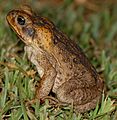Evolutionary arms race facts for kids
An evolutionary arms race describes a situation where two species are so closely linked that a change in one causes a change in the other. It's like a never-ending competition! This idea comes from the "arms race" between countries, where each side develops new weapons because the other side does. In nature, it's a type of coevolution, meaning two species evolve together, influencing each other.
Contents
How Do Arms Races Happen?
Evolutionary arms races often happen in a few main ways:
Predator vs. Prey
This is a classic example. When a predator develops a new way to catch its prey, the prey must find a new defense. If the prey gets better at escaping, the predator has to become even better at hunting.
Running Faster to Survive
Think about Gazelles and cheetahs. Gazelles run very fast to escape. Cheetahs also run incredibly fast to catch them. Both animals have gotten faster over time because of this ongoing chase. Each improvement in one animal's speed pushes the other to get even quicker.
Plants and Dinosaurs
Long ago, some Conifer trees grew very tall. This helped them stay out of reach of plant-eating sauropod dinosaurs. But then, some dinosaurs also grew taller. They kept eating the conifers, continuing the "race" for height.
Newts, Snakes, and Toxins
The rough-skinned newt and the garter snake show a clear arms race. Newts produce a strong poison. Garter snakes eat these newts. In places where both live, the newts make more poison. The snakes there have also evolved to resist this poison.
However, resisting the poison comes at a cost for the snakes. Their bodies work slower. Snakes that are very good at resisting the poison move slower than snakes that are not resistant. This shows the trade-off in an arms race.
Parasite vs. Host
Another common arms race happens between a parasite and its host. A parasite lives on or inside another living thing. The host's immune system tries to fight off the parasite. But the parasite then adapts to survive the host's defenses. This cycle of attack and defense keeps going.
Mating and Reproduction
Sexual selection can also lead to an arms race. This happens when animals choose their mates.
Female Choices and Male Traits
Female animals often choose their mates based on certain features. These features are called secondary sex characteristics. For example, a male bird might have bright feathers or a special song. If females prefer males with brighter feathers, males with duller feathers might not get to mate. This pushes males to develop even more impressive features to attract females.
Different Goals in Mating
Sometimes, male and female animals have different goals when they mate. This can create a kind of "sexual conflict" arms race. Each gender develops adaptations to get the best outcome for their offspring.
- Males: They often want to mate with many females. This helps spread their genes widely.
- Females: They usually want to mate with strong, healthy males. This helps them have many healthy and varied offspring.
These different goals can lead to an ongoing competition between males and females within the same species.
Images for kids
See also
 In Spanish: Carrera armamentista evolutiva para niños
In Spanish: Carrera armamentista evolutiva para niños




